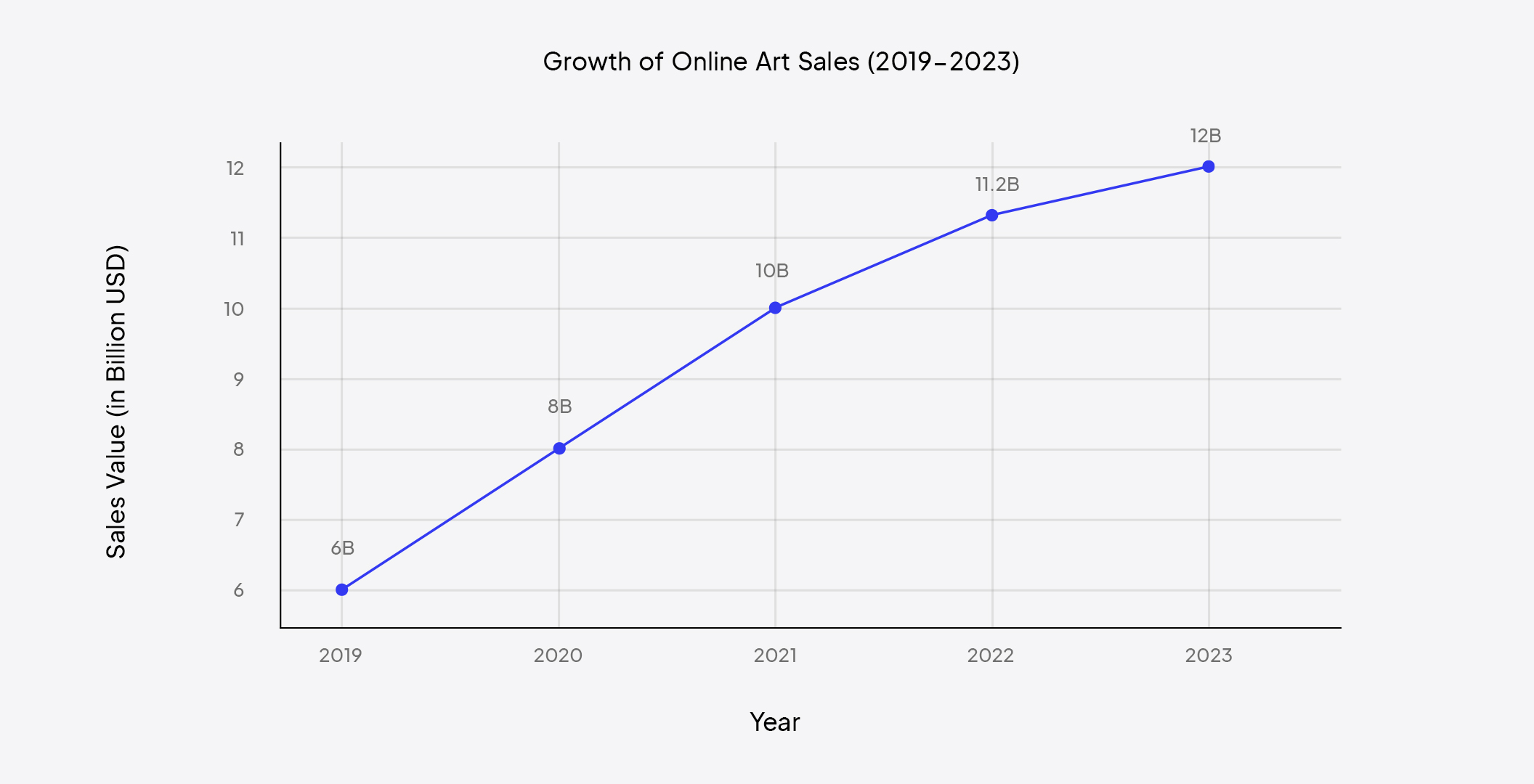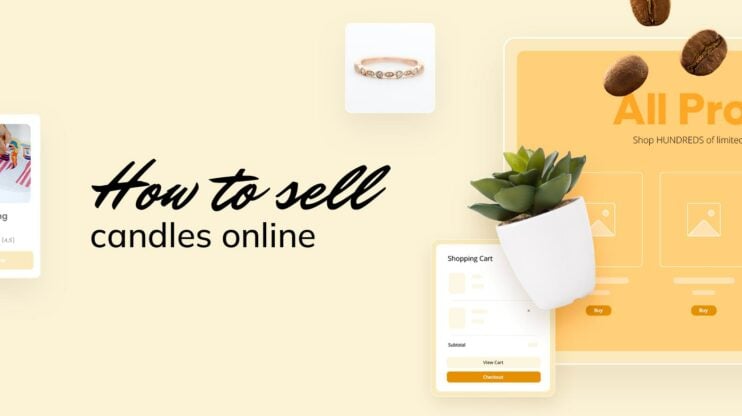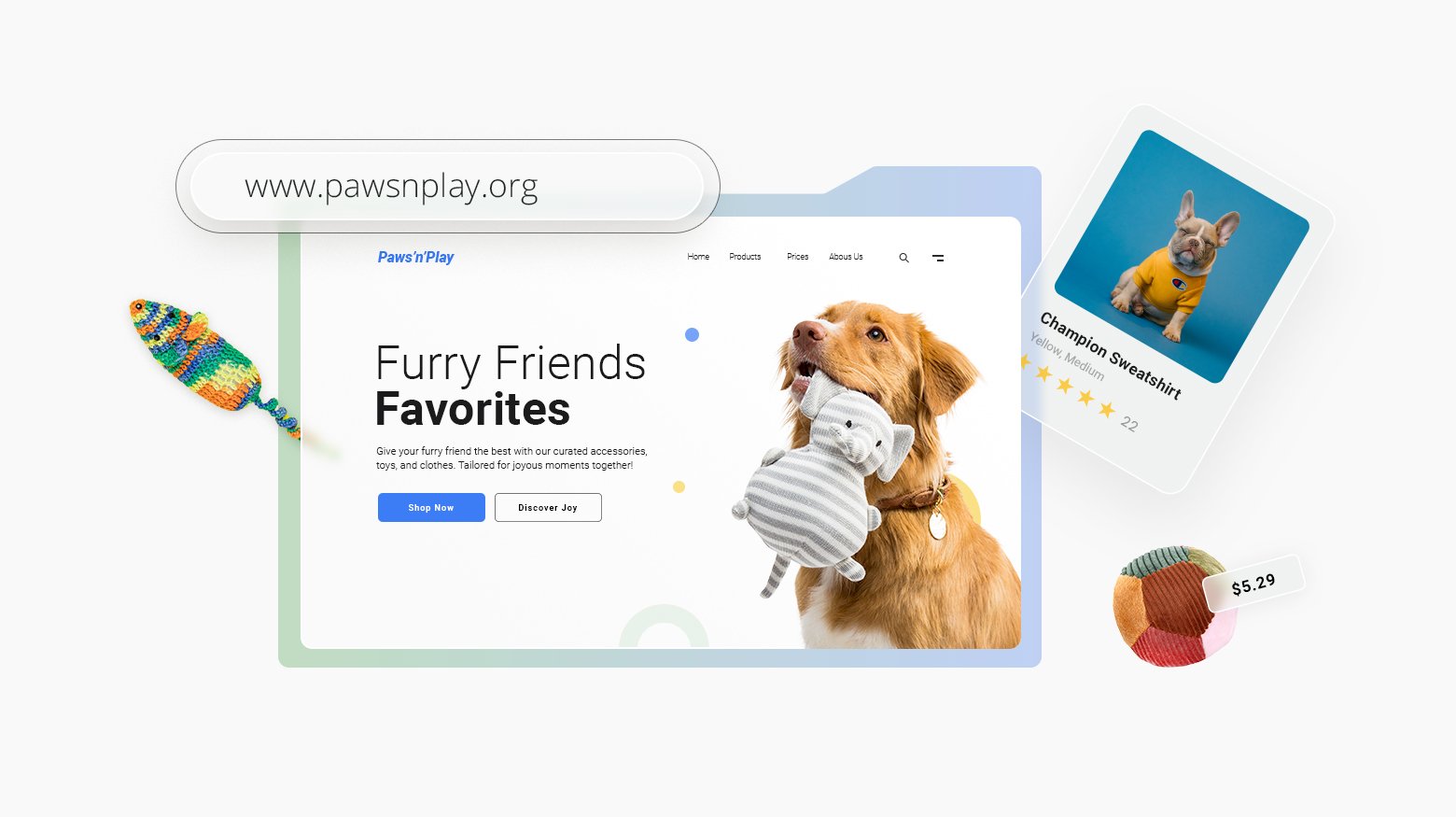Selling art online can feel stressful for many artists. I learned this firsthand during a wine-filled evening with my sister, listening to her struggles to turn her paintings into a business. Like many talented artists, she considered taking a commercial job instead of pursuing her passion. But that conversation sparked something. I couldn’t stop thinking about how rewarding it would be to help artists share their work with the world while earning from their creativity.
That evening led me down a path of researching every possible way to sell paintings online, and I’ll be sharing everything I discovered here. This guide breaks down the entire process into clear, practical steps that any artist can follow. No overwhelming jargon – practical advice that works.
Looking to sell online? Develop and launch your store with 10Web AI Ecommerce Website Builder.
Create your online store in minutes!
Deciding what to sell
I understand that your first steps might be overwhelming. Considering that online art sales have grown significantly, reaching $12 billion in 2023, it’s clear there’s a thriving market waiting for your creative work.

So, firstly let’s break down the different ways to sell your work online – I promise it’s simpler than it seems.
Original paintings vs. art prints
You face a key decision: selling original pieces, reproductions, or both. Original art means there’s only one version – like a painting done by hand. These pieces cost more because they’re unique, and some art buyers specifically want original works.
Making prints of artwork, called reproductions or prints, lets artists sell the same piece many times. Since machines can make lots of prints quickly, they cost less to buy. Many artists do both – they sell their original pieces and also offer cheaper prints.
When setting up an online art shop, be super clear about what buyers are getting. Each listing needs to say if it’s an original piece or a print. Good shops explain this right away: “This is the original painting” or “This is a high-quality print.” Being upfront helps buyers trust the shop and feel confident about their purchase.
Open vs. limited-edition prints
If you decide to sell prints, there are two ways to sell them. Regular prints, called open editions, mean you can make as many copies as people want to buy. These cost less, and you can make them whenever someone orders – no need to print extras or store inventory.
Limited edition prints are special – you pick a number, like 50 copies total, and that’s it. Each print gets signed and numbered, like “Print 5 of 50.” These cost more because buyers know they’re rare. Art collectors often prefer these since they’re getting something that not everyone can have.
Most artists try both to see what works. Regular prints help get your art into more homes, while limited editions appeal to collectors who want something more exclusive.
Digital art and fun products
Digital downloads are a simple way to sell art. Buyers get their art right away – no waiting for packages in the mail. They can use it as phone wallpaper, print it at home, or share it on their devices. Plus, you don’t have to deal with shipping or storage.
Your art can also go on all kinds of everyday items people love. Think t-shirts, greeting cards, and phone cases. Many artists start with one or two popular items (like mugs) and see what their buyers like best before adding more. Just make sure every product looks good – nobody wants a blurry print on their t-shirt.
Remember to keep your style consistent across everything you make. If someone loves your art enough to wear it on a shirt, they want it to look just as good as your original piece.
Running a multi-artist gallery
Selling other artists’ work alongside your own can bring more variety to your shop. Think of it like running a small gallery – you pick different art styles that work well together. This gives shoppers more choices and brings in people who might like different kinds of art.
Working with other artists starts with getting to know them and their work. If you’re an introvert like me and find talking to others challenging, start by connecting through email or art forums online. Many artists actually prefer writing about their work rather than explaining it face-to-face. Talk to artists about what their art means and how they want it presented. The best art sellers really understand each piece they’re showing, so they can tell its story to buyers.
Adding different artists to your shop makes it more interesting for people who collect art. They can browse through different styles all in one place. Plus, teaming up with other artists helps everyone – they get a new place to sell, and your shop gets new artwork to offer.
Preparing your artwork for sale
Now, let’s talk about making your art look amazing online. You can capture great photos using your phone, hire a professional photographer, or anything in between. And with some simple free editing apps, you can make your artwork photos look professional and appealing to buyers.
Photographing and scanning your paintings professionally
Taking good art photos is way simpler than most people think. These days, your phone can do the job perfectly – you just need decent lighting and the right setup. From what I’ve seen watching my sister sell her art online, it’s all about angles and avoiding glare.
Here’s what works: set up two lights (regular lamps are fine) at angles to your artwork. Play around until you don’t see any weird shadows or shine in your phone’s preview. If you want super professional results, hire a photographer, but honestly? A well-lit phone photo usually does the trick. This short Youtube video guide can help you master your phone camera as well.
For small pieces, just use a scanner. It’s foolproof and gives perfect lighting every time. Even bigger artworks aren’t a problem. I recently watched a super helpful DIY video on Pinterest (which I could not find later) about scanning your artwork in sections and joining them together with a basic photo app. Works like a charm.
Ensuring high-quality images for online listings
Now that you’ve got your photos, let’s make them look amazing online. Trust me, a few simple tweaks make a huge difference. I’ve spent way too much time browsing art listings online (it’s kind of addictive), and the ones that catch your eye always have crisp, clear photos.
Here too, you don’t need fancy software. Most phone editing apps can fix things like weird colors or lighting issues. There was a time when I swore by Snapseed – it’s free and easy to use. Just make sure your colors look as close as possible to the original artwork. And always use a plain background – white or gray works best. Here’s a short guide on how to edit your artworks through Snapseed.
Here’s another tip I picked up from successful art sellers: take photos from different angles. It helps show off any texture or shiny parts in your work. Plus, buyers love seeing close-up details – it’s the next best thing to seeing the art in person.
Showing off your art
A great way to sell art online is using two types of photos. First, take a picture of your painting on a wall or in a room setting – this helps buyers picture how it’ll look in their own space. This also helps in gauging the size of the image, whether it’s the original or the size of the print they want. Then snap what I call “catalog shots” – just the artwork against a plain wall, showing all the details clearly. People want a good look at what they’re buying and want to imagine it in their home.
Looking to sell online? Develop and launch your store with 10Web AI Ecommerce Website Builder.
Create your online store in minutes!
Printing and fulfillment options
When selling paintings online, choosing between DIY or professional printing can greatly influence your process. Print-on-demand services offer scalable solutions, making it easy to meet demand without the hassle of inventory management.
DIY printing vs. professional printing services
Let’s talk about making prints of your artwork. You’ve got two options here – doing it yourself at home or using a print shop. Both are great choices, just for different situations.
If you want to print at home, you’ll need a good printer and quality paper. Some printers, like fine art printers, can even print on canvas. While these printers aren’t cheap (typically $3,000+), they can be a worthwhile investment depending on the scale of your business and your budget. It’s perfect when you’re testing things out or just starting to sell prints. You can make them whenever you want, which is pretty convenient.
Print shops are fantastic for bigger projects or when you need that extra-professional look. They’ve got these amazing printers that can handle all sorts of materials – not just paper, but things like canvas and acrylic too. They usually work better when you’re making lots of prints at once.
Here’s a quick comparison of printing at home vs. using a print shop to help you decide which works best for your needs.
| Aspect | Printing at home | Using a print shop |
| Control | Full control over the printing process, including colors, paper types, and sizes. | Limited control as the shop handles the printing, but you can specify preferences. |
| Cost | Initial cost for a good printer and quality paper; cost-effective for small print runs. | Higher upfront cost per print but offers discounts for bulk orders. |
| Quality | Depends on the printer and paper used; may not match professional print shop quality. | High-quality, professional-grade prints with advanced printers and materials. |
| Flexibility | Print on demand, experiment with different papers and sizes without large commitments. | Less flexible for small quantities; often requires a minimum order for cost-effectiveness. |
| Time commitment | Time-intensive; requires setup, maintenance, and manual work for each print. | Saves time; the shop manages the entire process, from setup to final output. |
| Scalability | Not ideal for large volumes; time and equipment wear increase with higher demand. | Best for larger projects and bulk printing, including specialized mediums like canvas or acrylic. |
| Convenience | Print anytime at home, but requires maintaining supplies and equipment. | Convenient for large batches or specialized projects, but requires coordination with the shop. |
| Experimentation | Great for testing and experimenting with designs or paper types. | Limited experimentation unless you order proofs, which can add to the cost. |
| Best For | Beginners or artists producing small runs, wanting control and the ability to experiment. | Artists producing large runs, selling professionally, or requiring high-quality materials. |
Think about what you really need first. How many prints? What quality? Write down all the costs – both for buying a printer and using print shops. My advice is to be as realistic as you can.
Time matters too. Some people love the DIY process, others prefer having experts handle everything. Small local print shops are worth checking out – they’re usually more flexible with small orders than big online companies.
Once you think it through, the choice usually becomes pretty clear.
Print-on-demand services for scalable sales
If you are thinking about scaling, print-on-demand services make your job simpler. They do all the printing and shipping while you focus on creating. When someone buys your art, these companies print it and send it directly to them.
Sites like Society6 or Printify keep things easy. Just upload your artwork, choose your products – maybe posters, canvases, or phone cases – and set your prices. They handle the rest, getting your art to buyers anywhere in the world.
The whole system runs without storing any inventory. No upfront costs, no boxes of prints filling up your space. Test different designs and products whenever you want. Zero risk if something doesn’t sell.
Note: Check out the comparison of print-on-demand services in the resources section below for more options.
Pricing your artwork
Pricing your art right means you’ll make money while keeping customers happy.
First, add up what you spend. Count all your supplies (canvas, paint, brushes) and the hours you work on each piece.
Look at what other artists charge for similar art. If people are buying lots of art like yours, you can charge more.
Remember that galleries and websites take a cut of your sales. Add this to your price so you still make money after they take their share.
Pricing tip: Price originals highest since they’re one-of-a-kind, make prints cheaper but still profitable (especially limited editions), and keep digital downloads affordable since they cost nothing to reproduce.
Building your artist brand
Standing out as an artist online starts with showing who you really are. Your unique story, the way you present your art, and how you connect with your audience – it all matters. Let’s look at simple ways to build your artist brand and make genuine connections with people who love your work.
Creating a portfolio and online presence
Every artist needs a good portfolio to show their work and build trust. Pick your best pieces and put them on a simple, clean website that looks good on phones. You can use website builders like 10Web that make this easy – you don’t need to be a tech expert.
Share your art journey with your audience. Take photos or videos while you work, or write simple posts about how you make your art. People love seeing how art comes to life.
Use social media like Instagram, TikTok, and Pinterest to reach more people. A 2020 survey revealed that 87% of art buyers use Instagram to find new artists, a substantial increase from 48% in 2016.
Post regularly and talk with your followers. When people comment on your art, write back – it helps build a community around your work.
While showing your face can help people trust you more easily, it’s not that important. Many successful artists only share their work, their hands while painting, or use voice-overs for their videos.
Leveraging social proof and customer testimonials
Good paintings sell better when people trust you as an artist and know others have had a great experience buying your work. Ask happy customers to share their experiences with your art. Post these reviews on your website and social media so new buyers feel confident buying from you.
Ship your art in beautiful packaging (it can look nice and be affordable at the same time). Happy customers often share photos online, which brings in more buyers.
If you enjoy meeting people, try art shows. They’re great for connecting with buyers, but selling online works just as well.
Setting up an online store
This step might seem complicated if you are a non-tech person. But the current market offers accessible tools for you that make this process simpler and even enjoyable. With a few core pages and some basic setup, you’ll have a professional space to show and sell your work.
Essential website pages and design best practices
A well-designed website needs four main pages to work effectively. Key pages include Home, Shop, About, and Contact.
- The Home page should give a warm welcome and show off your best art.
- The Shop page needs to be simple to use, with clear prices and great photos.
- The About page is where you tell your story and connect with people.
- The Contact page should make it easy for people to reach you, with clear details like email, phone, and a simple form.
All these pages need consistent design that works on phones, tablets, and computers. Stick to simple layouts with clear navigation – anything fancy just gets in the way of showing your art.
Creating your paintings store with 10Web
This section isn’t just based on theory – it’s shaped by real-life success stories. Take Mariella Paints, for example. This one-of-a-kind online gallery showcases Italian painter Mariella Paolini’s work, inspired by her travels and rich cultural experiences. Her story, much like many artists’, began with a dream to share her passion globally, which became a reality through a beautifully crafted website on 10Web.
After making the switch to 10Web, this online art gallery saw an impressive 21% boost in sales within just one month. With the help of AI-powered tools, they optimized their ecommerce operations, making it easier to show their artwork, connect with new audiences, and deliver a shopping experience that truly highlights the value of their paintings.
Setting up a store with 10Web is simple and provides several useful tools. Here are some steps to guide you:
- Visit the 10Web AI Website Builder – Enter a short description of your business and click Generate Your Website to start the process.
- Provide your store information – Add your company name and refine your business description if needed.
- Define product categories – Enter your product categories and let AI automatically generate a structured website for you.
- Refine your website structure – Adjust the suggested layout if necessary, knowing you can always customize it later.
- Personalize your design – Experiment with fonts, colors, and styles to match your brand identity.
- Generate your website – Click Generate to create your fully designed website in seconds.
This may still seem overwhelming, but 10Web has exceptional support for artists – it comes with a dedicated support team always ready to help. When we interviewed Mariella Paints, they shared how important this support was for them. On January 1st, at 2:00 a.m., they needed help switching to a new ecommerce shop layout. A support engineer responded immediately and solved the issue on the spot. This showed that 10Web isn’t just about great tools—it’s about a team that truly cares. With this kind of support, you’ll never feel stuck, no matter the time or problem.
Thanks to 10Web, I was able to create a space that truly highlights the beauty and meaning behind my mother’s art. This website isn’t just an online store—it’s a door of opportunity and a source of pride for her.
Looking to sell online? Develop and launch your store with 10Web AI Ecommerce Website Builder.
Create your online store in minutes!
Selling on marketplaces
You can use other platforms to sell your paintings online, other than your website.
Etsy excels for handmade and downloadable art, offering quick setup and a supportive community. Buyers there specifically seek unique, handmade pieces. eBay‘s global marketplace lets artists auction work or set fixed prices, reaching buyers worldwide.
Fine Art America manages print production and shipping directly to customers, freeing artists to focus on creating. Saatchi Art attracts serious collectors seeking investment pieces. Artists should select platforms that match their style and target buyers.
Simple marketing for your art
Getting your art in front of the right people takes some planning, but it doesn’t have to be complicated.
First, think about who would love your art. Are they young professionals decorating their first home? Art collectors? Knowing your audience helps you reach them better.
Build a simple artist website that shows off your work clearly (as advised above). Use good photos of your art and write descriptions that help people find you through Google searches. You can use this SEO-guide as support.
Share your art on social media. Post regularly, but focus on quality over quantity. If you have some money to spend, try small paid ads to reach more people (but don’t forget to target your audience first).
Collect email addresses from people interested in your work. Send them updates about new pieces and special offers. Keep your emails friendly and personal.
Consider telling stories about your art through blog posts or videos. People connect better with art when they understand its meaning or how it was made.
Remember: you don’t need to do everything at once. Start with what feels comfortable and add more as you grow.
Additional revenue streams
Let’s look at some fun ways to share your work beyond the internet – from local galleries to art fairs and more.
Creating different ways to earn from your art gives you more time to focus on your creative practice.
By diversifying your offerings—like selling prints, creating digital downloads, or licensing your work—you can ensure a steady income while pursuing your passion.
Selling in galleries, art fairs, and pop-up shops
Gallery shows, art fairs, and pop-ups each offer unique ways to sell your art in person, each attracting its own type of buyer. Almost 90% of high-net-worth collectors checked out a gallery or art fair’s online viewing room (OVR) in 2021. This shows that while people still love visiting art spaces in person, digital interactions are becoming a big deal too.
| Selling approach | Description | Advantages |
| Galleries | Connect you with serious art buyers through curators and gallerists who understand collector preferences. | Matches your work with the right buyers, accesses audiences you might not reach otherwise. |
| Art fairs | Allow direct interaction with buyers at your own booth. Buyers enjoy meeting artists and learning the stories behind the artwork. | Builds personal connections, which drive most sales at fairs. |
| Pop-up shows | Take place in unexpected venues like markets or empty shops, attracting new audiences. | Provides exposure to non-traditional art buyers, involves creating attractive displays and collaborating with other artists. |
Partnering with retail stores and boutiques
Local boutiques and shops can help sell your artwork to new audiences. I’ve found that stores welcome unique pieces that fit their style, and they handle all the customer interactions while you paint.
Clear agreements make store partnerships work smoothly. Talk about pricing, display needs, and payment terms before you start. Some shops may want to be the only place that sells certain pieces – this often works well since they’ll promote exclusive artwork more actively.
These stores bring built-in customers who already trust their choices. When store owners display your art, you connect with their loyal shoppers right away. Start with one store to test this approach before growing.
Licensing art for commercial use
Letting companies put your art on their products can bring in regular money. It works like this: a company sees your art and wants to use it on their coffee mugs or t-shirts. They pay you each time they use your design – this payment is called a royalty.
Many companies look for new art to put on their products. A cute cat drawing might end up on pillows, phone cases, or even beach towels. Each new product means more money coming in without having to create new artwork.
Taking on special projects with specific companies can work well too. Maybe a local coffee shop wants your art only on their mugs, or an office wants your nature scenes just for their walls. These deals often last a long time, which means steady income. Once you create the art, you can earn money from it over and over.
Understanding copyright & protecting your work
Whichever model you choose for your business, my recommendation is to take art protection seriously because I’ve seen what happens when artists don’t.
Basic protection steps
Your artwork gets automatic copyright protection when you create it – this means you own it and control how it’s used. I recommend registering your most important pieces with the copyright office. It’s simple: submit forms, images, and a small fee. This registration makes it much easier to defend your work if someone copies it.
Monitoring your work
Keep an eye out for unauthorized copying online and offline. I regularly search for my artwork on the internet to catch any misuse early. Some copycats make exact copies, while others try to hide theft by making small changes. Both are illegal.
Sales and permissions
Track every sale and permission you give for using your work. I keep a simple spreadsheet with dates, buyer details, and what rights they received. When working with other artists’ pieces in your shop, always get their written permission first.
Legal agreements
Use clear contracts when selling your art. State exactly what buyers can and can’t do with the work – like whether they can make prints or use it commercially. For bigger deals or when you’re unsure, talk to a copyright lawyer. It’s worth the cost to avoid problems later.
Conclusion
Every artist’s journey into online sales looks different. Many artists start small – maybe just a few prints on Etsy – and grow naturally from there. There is no need to do everything at once.
Looking back at all the options we’ve explored – from original painting to limited editions, from online marketplaces to gallery partnerships, from social media sharing to art licensing – the path forward becomes clear: start with one approach that fits your art and your style. Your creative business will naturally evolve as you learn what connects best with your collectors.
FAQ
How do beginners sell paintings?
Which site is best for selling paintings?
Is it profitable to sell art online?
Looking to sell online? Develop and launch your store with 10Web AI Ecommerce Website Builder.
Create your online store in minutes!













